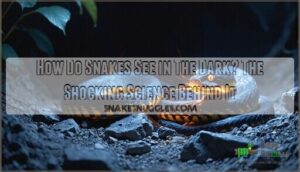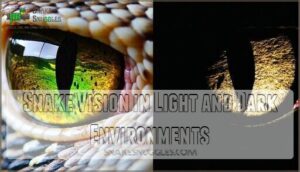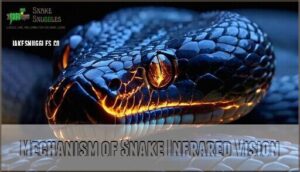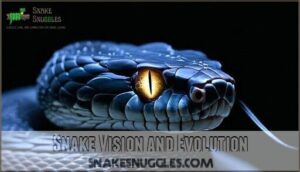This site is supported by our readers. We may earn a commission, at no cost to you, if you purchase through links.
 You’d be amazed at how snakes see in the dark – they’re basically living thermal cameras!
You’d be amazed at how snakes see in the dark – they’re basically living thermal cameras!
While not all snakes have this superpower, species like pythons and vipers use specialized pit organs to detect infrared radiation from warm-blooded prey.
Think of it as nature’s night-vision goggles, allowing them to "see" heat signatures in complete darkness.
These organs sit between their eyes and nostrils, working like tiny heat detectors that create thermal images in their brains.
It’s like having a built-in radar system that never needs batteries.
The science behind this remarkable ability reveals even more fascinating secrets about snake evolution.
Table Of Contents
- Key Takeaways
- How Do Snakes See in The Dark?
- Snake Vision Basics
- Snake Vision in Light and Dark Environments
- Mechanism of Snake Infrared Vision
- Role of Pit Organ in Snake Vision
- Snake Vision and Evolution
- Frequently Asked Questions (FAQs)
- What does a snakes vision look like?
- Do snakes have dark vision?
- What do snakes do in the dark?
- How can a snake see a mouse in the dark?
- Why do some snakes have poor vision?
- How do snakes see using infrared?
- How do pit organs work?
- How has snake vision evolved?
- What are the advantages of snake vision?
- Do all snake species have thermal vision?
- Conclusion
Key Takeaways
- You’ll find that only certain snake species like pit vipers, pythons, and boas can truly "see" in the dark using specialized pit organs that detect infrared radiation from warm-blooded prey.
- You’re witnessing nature’s thermal camera system when snakes hunt at night – their pit organs contain ultra-thin membranes with heat-sensitive cells that convert temperature differences into electrical signals.
- You should know that snakes don’t rely on traditional vision in darkness since they can detect temperature changes as small as a few thousandths of a degree, creating detailed heat maps of their surroundings.
- You can understand snake evolution better by recognizing that nocturnal species lack UV filters in their eyes and have vertical slit pupils that maximize light intake, while day-hunting snakes developed protective UV layers for clearer daytime vision.
How Do Snakes See in The Dark?
In the dead of night, when you can’t see your hand in front of your face, certain snakes hunt with deadly precision. How do they pull off this incredible feat? The answer lies in their extraordinary infrared vision capabilities that put night-vision goggles to shame.
Snakes turn darkness into their hunting ground, wielding thermal superpowers that make them nature’s ultimate night predators.
Nocturnal snakes like pit vipers have evolved a remarkable biological radar system that detects heat signatures from warm-blooded prey. Their specialized pit organs act as thermal cameras, creating detailed heat maps of their surroundings through infrared detection range that spans several feet.
This thermal image formation happens through neural processing so sophisticated that scientists are still unraveling its mysteries. Environmental adaptation has fine-tuned this snake vision over millions of years. Pit organ evolution created these living heat sensors that can detect temperature differences as small as a few thousandths of a degree, making thermal vision their secret weapon for survival.
These organs rely on TRPA1 proteins for heat detection.
Snake Vision Basics
Most snakes possess remarkably different vision systems compared to humans, with specialized adaptations that give them unique advantages in their environments.
Unlike your three-color vision, snake eyes typically detect only two primary colors through dichromatic vision, similar to red-green colorblindness. Their lens adaptation allows UV sensitivity, while pupil shape varies dramatically between species.
Here’s what makes snake vision extraordinary:
- Color perception remains limited but highly specialized for survival
- Visual acuity varies dramatically between day-hunting and nocturnal species
- UV sensitivity enhances their ability to detect prey and navigate
- Nocturnal vision adaptations help them thrive in low-light conditions
Snake Vision in Light and Dark Environments
You might think all snakes struggle equally in bright sunlight and pitch-black darkness, but that’s not quite accurate.
Day-hunting species have developed UV-filtering eye layers that protect them from harsh sunlight and sharpen their vision, while night-hunting snakes lack these filters, giving them enhanced abilities to see in low-light conditions.
Daytime Vision
When the sun rises, snakes become visual champions through remarkable adaptations.
Unlike their nighttime counterparts, diurnal species possess a specialized UV filter that blocks harmful ultraviolet radiation while enhancing visual acuity.
This lens adaptation allows day-hunting snakes to see with crystal-clear precision.
Snake eyesight during daylight relies on sophisticated color perception systems.
While you see three primary colors, snake eyes detect two—blue and green—but with incredible sharpness thanks to their spherical lens design.
| Daytime Feature | Function |
|---|---|
| UV Filter Layer | Protects eyes, improves clarity |
| Spherical Lens | Enhanced focus for swift movement |
| Two-Color Vision | Blue and green detection |
Diurnal species like false water cobras demonstrate excellent snake vision capabilities.
Their animal vision system prioritizes movement detection and heat signatures over detailed imagery.
This snake senses combination makes them formidable daytime hunters, proving that bright light enhances rather than hinders their predatory success.
Nighttime Vision
When darkness falls across the landscape, you’ll discover that snakes transform into remarkably efficient nocturnal hunters through fascinating Nocturnal Adaptations. Unlike day-hunting species, night-active snakes lack UV-filter layers over their eyes, dramatically enhancing their night vision capabilities in Low-Light Hunting scenarios.
Snake eyesight during nighttime relies on two critical adaptations:
- Vertical slit-shaped pupils expand dramatically in darkness, maximizing light intake while providing precise depth perception for striking accuracy.
- Enhanced rod cell density in their retinas amplifies available light, allowing them to detect subtle movements that would be invisible to human eyes.
Pit vipers excel at nighttime hunting through Infrared Sensitivity, combining thermal detection with visual cues. Their Sensory Integration creates a multi-dimensional perception of their environment, merging how snakes see with infrared detection capabilities. This combination makes them incredibly effective predators, capable of tracking warm-blooded prey through complete darkness with startling precision. Many species also possess a tapetum lucidum, further enhancing their night vision.
Mechanism of Snake Infrared Vision
When you think about how these remarkable creatures detect heat, picture their pit organ as a sophisticated antenna that captures infrared radiation from warm-blooded prey.
Nature’s most advanced thermal camera isn’t made of silicon—it’s living tissue that detects heat with deadly precision.
This heat sensing system converts thermal energy into electrical signals through cellular voltage mechanisms, where specialized cells act like soft pyroelectrics.
TRPA1 proteins play a vital role in this infrared detection process, enabling thermal image formation in complete darkness.
Snakes rely on specialized heat-sensitive receptors to detect minute temperature changes.
The vision mechanism transforms temperature differences into actionable information, allowing snakes to "see" heat signatures with remarkable precision and accuracy.
Role of Pit Organ in Snake Vision
You’ve learned how snakes detect infrared radiation, but you might wonder what structure actually makes this thermal vision possible.
The pit organ, a specialized hollow chamber found in vipers, boas, and pythons, acts as nature’s thermal antenna, using a thin membrane filled with heat-sensitive cells to transform temperature differences into electrical signals.
These electrical signals create thermal images of the snake’s surroundings.
Structure and Function
You might wonder how pit vipers transform heat into vision.
The pit organ features a hollow chamber enclosed by an ultra-thin membrane that’s incredibly sensitive to temperature changes.
This specialized Pit Organ Anatomy enables precise Infrared Detection by detecting minute thermal variations.
The Membrane Sensitivity captures heat signatures from warm-blooded prey, while cellular mechanisms process this data for Thermal Image Formation.
The Cellular Voltage Role converts thermal energy into electrical signals, creating a sophisticated heat sensing system.
Some species also have adaptations for excellent low-light vision.
Here’s how this remarkable thermal imaging system works:
- The membrane is thinner than paper, maximizing heat sensitivity
- Specialized cells act like biological thermometers detecting temperature shifts
- Heat signatures create electrical patterns that form thermal maps
- Multiple pit organs provide stereoscopic thermal vision for depth perception
- The system works instantly, giving snakes split-second hunting advantages
Pyroelectric Properties
Understanding how snakes achieve thermal imaging requires exploring the remarkable pyroelectric properties within their pit organs.
These specialized cells don’t contain traditional pyroelectric materials, yet they function identically by converting infrared radiation into electrical signals.
The secret lies in cellular voltage – each cell possesses natural electrical potential that enables induced pyroelectricity when exposed to temperature variations.
Think of these cells as biological sensors that generate electric charges when thermal stress occurs.
This soft pyroelectrics mechanism allows snakes to detect millikelvin-level temperature differences, creating detailed thermal images of their surroundings.
The pit organ membrane acts like a sophisticated antenna, capturing heat signatures from warm-blooded prey even in complete darkness.
- Cellular voltage enables pyroelectric behavior without actual pyroelectric compounds
- Induced pyroelectricity converts thermal radiation into processable electrical signals
- Soft pyroelectrics demonstrate nature’s innovative material applications
- Temperature detection operates at incredibly sensitive millikelvin levels
- Research implications extend to developing bio-inspired thermal sensors
This discovery bridges the gap between biology and materials science, revealing nature’s ingenious thermal detection system.
Snake Vision and Evolution
Beyond the remarkable thermal sensing abilities of pit vipers, snake vision has undergone millions of years of fine-tuning.
You’ll find that pupil shape varies dramatically across species – from round pupils in diurnal hunters to vertical slits in nocturnal predators.
This evolutionary advantage maximizes light control for different hunting schedules.
Most snakes retained UV sensitivity from their ancestors, enhancing nocturnal vision capabilities.
Their color vision adapted to detect two primary wavelengths, perfectly suited for tracking prey movement.
Sensory integration combines thermal sensing with traditional sight, creating a sophisticated hunting system that processes both infrared radiation and visible light simultaneously.
| Vision Adaptation | Daytime Hunters | Nocturnal Species |
|---|---|---|
| Pupil Shape | Round pupils | Vertical slits |
| UV Filtering | Blocks UV rays | Permits UV light |
| Color Detection | Enhanced blue-green | Limited spectrum |
| Thermal Integration | Basic heat sensing | Advanced infrared |
| Light Sensitivity | Reduced sensitivity | Maximum sensitivity |
Frequently Asked Questions (FAQs)
What does a snakes vision look like?
Snake vision is quite limited compared to yours.
They see only two primary colors – blue and green – creating a simplified world.
Their eyes detect movement and basic shapes, but they can’t form sharp, detailed images like you do, which is related to their ability to see only in blue and green.
Do snakes have dark vision?
Like night-vision goggles for predators, you’ll find that certain snakes don’t rely on traditional "dark vision" but instead use specialized pit organs to detect infrared heat signatures from warm-blooded prey in complete darkness.
They use these infrared heat signatures to locate their prey.
What do snakes do in the dark?
In darkness, you’ll find snakes actively hunting using their pit organs to detect warm-blooded prey through infrared radiation.
They’re not sleeping—they’re prowling, sensing heat signatures and vibrations to locate unsuspecting meals.
How can a snake see a mouse in the dark?
When you’re wondering how snakes spot mice in complete darkness, they’re using specialized pit organs that detect infrared heat signatures.
These thermal sensors create heat maps, letting them "see" warm-blooded prey without any light, using infrared heat signatures.
Why do some snakes have poor vision?
Ever wonder why nature didn’t give all snakes perfect eyesight.
You’ll find that most snakes rely on basic two-color vision because they’ve evolved to depend more heavily on heat detection, vibration sensing, and chemical tracking for survival, utilizing basic two-color vision.
How do snakes see using infrared?
You’ll find that pit vipers, pythons, and boas use specialized pit organs to detect infrared radiation from warm-blooded prey.
These hollow chambers contain cells that convert temperature differences into electrical signals, creating thermal images.
How do pit organs work?
Like nature’s thermal antenna, your pit organ acts as a hollow chamber with a thin membrane that detects infrared radiation.
Specialized cells inside use electrical voltage to convert temperature changes into thermal images.
How has snake vision evolved?
Snake vision adapted for survival needs.
You’ll find day-hunters developed UV filters for clearer sight, while night-hunters enhanced low-light capabilities.
They evolved specialized pit organs to detect infrared radiation from warm-blooded prey.
What are the advantages of snake vision?
Most snakes see only two colors while you see three, yet they’ve mastered survival through superior thermal detection, UV sensitivity, and motion tracking.
They’ve developed these abilities to let them hunt effectively in complete darkness.
Do all snake species have thermal vision?
Not every snake species possesses thermal vision capabilities.
Only pit vipers, pythons, and boa constrictors have specialized pit organs that detect infrared radiation, allowing them to "see" heat signatures in complete darkness.
Conclusion
Surprisingly, the theory that snakes are blind hunters couldn’t be further from reality.
Understanding how snakes see in the dark reveals nature’s most sophisticated thermal detection system, where pit organs transform invisible heat waves into vivid mental maps.
You’ve discovered that these serpentine predators don’t stumble through darkness—they navigate with precision that puts our technology to shame.
Next time you encounter a snake’s unwavering gaze, remember you’re witnessing millions of years of evolutionary engineering perfection.
- https://a-z-animals.com/animals/snake/snake-facts/how-do-snakes-see-their-vision/
- https://academic.oup.com/mbe/article/33/10/2765/2925616
- https://www.quora.com/Why-are-snakes-not-able-to-see-in-the-dark
- https://www.berrypatchfarms.net/can-snakes-see-in-the-dark/
- https://www.egr.uh.edu/parameters/2021-spring/how-do-snakes-see-dark











